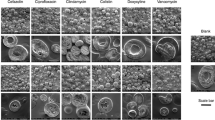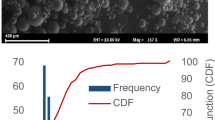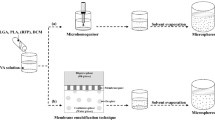Abstract
Purpose. To measure changes in pH as well as osmotic pressure in aqueous pores and cavities inside biodegradable microspheres made from polymers such as poly(D,L-lactic acid) (PLA) and poly(D,L-lactic acid -co- glycolic acid) (PLGA).
Methods. The internal osmotic pressure inside eroding PLA microspheres was analyzed with differential scanning calorimetry (DSC) in a temperature range of 10 to −25°C. The osmotic pressure was calculated from the melting peaks of the aqueous phase using purity analysis. For pH determination, PLGA microspheres were loaded with a pH-sensitive spin probe which allowed the determination of pH by electron paramagnetic resonance (EPR).
Results. The osmotic pressure in PLA microspheres increased to 600 mOsm within four days and decreased to 400 mOsm after two weeks. The pH in PLGA microspheres in this study was ≤4.7. Basic drugs such as gentamicin free base or buffering additives led to a pH increase. In no case, however, did the internal pH exceed a value of 6 within 13 hours.
Conclusions. DSC and EPR are useful techniques to characterize the chemical microenvironment inside eroding microspheres. This data in combination with detailed information on peptide and protein stability could allow in the future to predict the stability of such compounds within degradable polymers.
Similar content being viewed by others
REFERENCES
H. V. Maulding. Prolonged delivery of peptides by microcapsules. J. Contr. Rel. 6:167–176 (1987).
C. Thomasin, G. Corradin, Y. Men, H. P. Merkle, and B. Gander. Tetanus toxoid and synthetic malaria antigen containing poly(lactide)/poly(lactide-co-glycolide) microspheres: importance of polymer degradation and antigen release for immune response. J. Contr. Rel. 41:131–145 (1996).
H. Okada, Y. Doken, Y. Ogawa, and H. Toguchi. Preparation of three-month depot injectable microspheres of leuprorelin acetate using biodegradable polymers. Pharm. Res. 11:1143–1147 (1994).
S. Cohen, T. Yoshioka, M. Lucarelli, L. H. Hwang, and R. Langer. Controlled delivery systems for proteins based on poly(lactic/glycolic acid) microspheres. Pharm. Res. 8:713–720 (1991).
M. J. Blanco Prieto, F. Delie, E. Fattal, A. Tartar, F. Pusieux, A. Gulik, and P. Couvreur. Characterization of V3 BRU peptideloaded small PLGA microspheres prepared by a (w1/o)w2 emulsion solvent evaporation method. Int. J. Pharm. 111:137–145 (1994).
J. Herrmann and R. Bodmeier. Somatostatin containing biodegradable microspheres prepared by a modified solvent evaporation method based on W/O/W-multiple emulsions. Int. J. Pharm. 126:129–138 (1995).
S. P. Schwendeman, H. R. Costantino, R. K. Gupta, and R. Langer. Progress and challenges for peptide, protein and vaccine delivery from implantable polymeric systems. In: K. Park (ed.), Controlled Drug Delivery: Challenges and Strategies. American Chemical Society, Washington, pp. 229–267 (1997).
M. Morlock, H. Knoll, G. Winter, and T. Kissel. Microencapsulation of rh-erythropoetin, using biodegradable poly(D,L-lactide-co-glycolide): protein stability and the effects of stabilizing excipients. Eur. J. Pharm. Biopharm. 43:29–36 (1997).
K. Mäder, B. Gallez, K. J. Liu, and H. M. Swartz. Non-invasive in vivo characterization of release processes in biodegradable polymers by low-frequency electron paramagnetic resonance spectroscopy. Biomaterials 17:457–461 (1996).
T. G. Park, W. Lue, and G. Crotts. Importance of in vitro experimental conditions on protein release kinetics, stability and polymer degradation in protein encapsulated poly(D,L-lactic-co-glycolic acid) microspheres. J. Contr. Rel. 33:211–222 (1995).
M. C. Manning, K. Patel, and R. T. Borchardt. Stability of protein pharmaceuticals. Pharm. Res. 6:903–918 (1989).
V. V. Khramtsov and L. M. Weiner. Proton exchange in stable nitroxide radicals: pH-sensitive spin probes. In: Imidazoline nitroxides, ed. Volodarsky, L. B. (CRC press, Boca Raton, FL), Vol. 2, pp. 37–80 (1988).
K. Mäder, S. Nitschke, R. Stösser, H.-H. Borchert, and A. Domb. Non-destructive and localized assessment of acidic microenvironments inside biodegradable polyanhydrides by spectral spatial electron paramagnetic resonance imaging. Polymer 38:4785–4794 (1997).
K. Mäder, B. Bittner, Y. Li, W. Wohlauf, and T. Kissel. Monitoring microviscosity and microacidity of the albumin microenvironment inside degrading microparticles from polylactide-co-glycolide) (PLG) or ABA-triblock polymers containing hydrophobic poly(lactide-co-glycolide) A blocks and hydrophilic poly(ethylenoxide) B blocks. Pharm. Res. 15:787–793 (1998).
G. Zhu and S. P. Schwendeman. Stabilization of bovin serum albumin encapsulated in injectable poly(lactide-co-glycolide) millicylinders. Proceed. Int'l. Symp. Rel. Bioact. Mater. 25:267–268 (1998).
A. J. Domb, L. Turovsky, and R. Nudelman. Chemical interactions between drugs containing reactive amines with hydrolyzable insoluble biopolymers in aqueous solutions. Pharm. Res. 11:865–8 (1994).
A. A. van Dooren and B. W. Müller. Purity determinations of drugs with differential scanning calorimetry (DSC) — a critical review. Int. J. Pharm. 20:217–233 (1984).
B. Wunderlich. Thermal Analysis, Academic Press, Inc., San Diego. 1990.
W. P. Brennan, M. P. DiVito, R. L. Fyans, and A. P. Gray. An overview of the calorimetric purity measurement. Thermal Analysis Newsletter 5 and 6. The Perkin Elmer Corporation, Norwalk, Conneticut, USA.
T. G. Park. Degradation of poly(D,L-lactic acid) microspheres: effect of molecular weight. J. Contr. Rel. 30:161–173 (1994).
D. K.-L. Xing, D. T. Crane, B. Bolgiano, M. J. Corbel, C. Jones, and D. Sesardic. Physicochemical and immunological studies on the stability of free and microsphere-encapsulated tetanus toxoid in vitro, Vaccine 14:1205–1213 (1996).
L. Chen, R. N. Apte, and S. Cohen. Characterization of PLGA microspheres for the controlled delivery of IL-1α for tumor immunotherapy, J. Contr. Rel. 43(2,3):261–272 (1997).
T. Uchida, A. Yagi, Y. Oda, Y. Nakada, and S. Goto. Instability of bovine insulin in poly(lactide-co-glycolide) (PLGA) microspheres, Chem. Pharm. Bull. 44:235–6 (1996).
J. L. Cleland, A. Mac, B. Boyd, J. Yang, E. T. Duenas, D. Yeung, D. Brooks, C. Hsu, H. Chu, et al. The stability of recombinant human growth hormone in poly(lactic-co-glycolic acid) (PLGA) microspheres. Pharm. Res. 14:420–425 (1997).
P. A. Burke. Determination of internal pH in PLGA microspheres using 31P-NMR spectroscopy. Proc. Int. Symp. Controlled Release Bioact. Mater. 23:133–134 (1996).
A. Shenderova, T. G. Burke, and S. P. Schwendeman. Evidence for an acidic microclimate in PLGA microspheres. Proc. Int. Symp. Controlled Release Bioact. Mater. 25:265–266 (1998).
K. Fu, D. W. Pack, A. Laverdiere, S. Son, and R. Langer. Visualization of pH in degrading polymer microspheres. Proc. Int. Symp. Controlled Release Bioact. Mater. 25:150–151 (1998).
Author information
Authors and Affiliations
Corresponding author
Rights and permissions
About this article
Cite this article
Brunner, A., Mäder, K. & Göpferich, A. pH and Osmotic Pressure Inside Biodegradable Microspheres During Erosion1. Pharm Res 16, 847–853 (1999). https://doi.org/10.1023/A:1018822002353
Issue Date:
DOI: https://doi.org/10.1023/A:1018822002353




